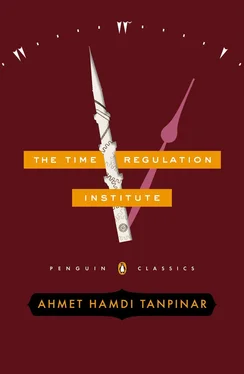My face went bright red with shame.
“I wish you’d done just that!” I said, wrenching myself free of his embrace.
“Now, what a ridiculous thing to say,” he said.
He smiled again and raised his glass.
“Be as you like, then,” he said. “In any event I never wanted to change you altogether! If that were the case, then we would no longer need each other. It’s just that you needed mild alterations here and there. At least that way you won’t disturb those around you, who are simply living out their lives!”
I paused for a moment. I was lost in doubt.
“You don’t believe in anything do you?” I asked.
He took a sip from his glass and then wiped his forehead with the handkerchief he’d taken out of his vest pocket:
“Enough already,” he said. “Look, our friends are coming this way. Long live the Time Regulation Institute! Long live the TRI!”
And with this toast, he saluted my entire family, including my aunt, who had taken Van Humbert by the arm.
Van Humbert’s delight knew no bounds. You’d think he’d just won a great victory. He congratulated me on my wife and my daughter and invited both of them to Holland. He said he would teach them how to ride a bicycle.
“Here we all ride the carousel together,” I said.
Halit Ayarcı looked at me reproachfully. It was clear something had changed between us.
Van Humbert stayed in Istanbul for one month. It would take far too much time for me to explain all the adventures we shared together, but allow me say just this: he left us quite pleased. Years later he described his visit to Istanbul in a series of articles. He never forgot his zeybek with my daughter, or Halit Ayarcı’s kind attention, or the yogurt kebab we feasted upon in Çamlıca on the day we visited the tomb of Ahmet the Timely.
I’d thought this man to be thoroughly pleased with me, and so it was a shock to see him turn against me. I can only think of the old saying, “A fallen man has no friends,” which was first uttered many years before my encounter with Van Humbert. And so I harbor no anger against him, nor dreams of vengeance. I just think it would have been so much better if he’d never come at all. But let’s not forget: Van Humbert suffered dearly for his involvement with us. In particular there was his book on ancient Turkic folklore; he’d based it on information gathered from my wife and my older sister-in-law, and it was savaged by the critics. Yet in his subsequent articles he continued to speak fondly of me. He concluded one with this sentence: “Hayri Irdal and his family know all too well how to reach a man’s inner essence. No matter what may happen between us, I’ll never forget the time I spent with them during my visit to Istanbul. As happy as they might be with the carousel, if they ever come to Holland, I shall keep my promise and teach them all how to ride a bicycle.”
PART IV.EVERY SEASON HAS AN END
I
Halit Ayarcı’s prediction came true. Within just a few months of my aunt’s cocktail party, we had received telegraphs from several agencies informing us that independent chapters of the Clock Lover’s Society had been established in six South American cities. It was not long before those groups were in direct communication with our own Clock Lover’s Society, requesting information on our charter, official rules, and regulations. Similar requests came in from all parts of the Middle and Far East, as well as from several countries in Europe. In the space of just two and a half years, three institutes and more than thirty Clock Lover’s Societies were established abroad. It was strange to see how, in countries ill disposed to such institutes, the authorities felt compelled to supply the public with clear and concise reasons for their opposition. In almost all cases the announcement was in fact the same: “Our industries are developed to a degree as to preclude the need for such an institute.”
And so it was that — whether or not they had an institute — all countries were united in viewing it as a necessity. Following each official telegraph to this effect, Halit Ayarcı organized a press conference at which he again emphasized our institute’s importance. When he was occupied elsewhere, the task fell to me. My aunt, meanwhile, became a storm of industry. She did not miss a single one of the International Clock Lover’s Society’s frequent congresses. For a time, she kept her packed suitcase ready in her bedroom, only to decide that it would be easiest to simply leave it ready in the entrance hall. On most of these trips abroad she was accompanied by my daughter and also (on occasion) her husband. When passing through customs in Istanbul, she was among those who could count on being recognized. She renewed her passport every year without fail. In addition to the ornamental treasures and jewels left to her by the street sweeper’s trade guild, she was awarded medals by seven or eight foreign powers. Meanwhile we were just as busy. With the capital raised from our twofold penalty system, we constructed our new building on Freedom Hill, and, in partnership with the cooperative established with support from Timely Banks, which received generous aid from the International Time Trust, we brought into being a unique residential development for our personnel, which came to be known as the Clock Houses.
Aside from the aforementioned cash-penalty system, my most notable — or, rather, most taxing — contribution to the institute was its new building. Though our cash-penalty system attracted a great deal of notice, it was, in my estimation, nothing next to the attention accorded to the erection of our new building. It was this edifice that led to my election as honorary member to the International Society of Architects, but in the beginning I had very little to do with it. As with all other affairs of this genre, we opted for an open competition. After I had composed the rules for this competition, Halit Ayarcı insisted on adding the following requirement: “an original and new style in harmony with modern-day realities and the institute’s name.” Perhaps out of anger — or perhaps because I wanted to ridicule him — I made a slight change to the last part of his (in my view entirely unnecessary, but in the view of Halit Ayarci all-important) addendum: “and in a manner that embodies its name inside and out.”
This final condition — that the building should comply with its name, both inside and out — was what kept me working on the project for many a long month.
When the competition rules and regulations were published in the papers, they were generally accepted as reasonable. We are cursory readers at best. And, sadly, our overuse of terms like “modern-day realities,” “harmony,” and “inside and out” has led to their becoming worn phrases stretched way beyond their original shape. Thus the competition entries were nothing more than designs for commonplace buildings with a few stock innovations. It was a surprise to us all that a man like Halit Ayarcı would cling to his words till the end, refusing all others the chance to interpret their meaning. Yet he rejected every last entrant, and each time he justified his decision by referring to the clause that I had included out of obstinacy and a taste for irony, saying that the proposal in question did not comply with the idea inside and out.
“What part of this facade resembles a clock?”
That was his first question. And the second came right on its heels:
“And in what way did you express the essence of timepieces, or of time and regulation, in the building’s interior?”
The architects who had entered the competition were unable to answer these questions to his satisfaction, and so they were asked to leave. Never before, and not even during the days of liquidation, had so many pieces critical of the institute appeared in the press. These architects would storm out the front door, with their blueprints stuffed under their arms, and head straight for a newspaper office. Article after article cropped up in the daily papers. We were quick to jump to action and rebut the charges. Halit Ayarcı held one press conference after another, and the message was always this: “Modern man does not engage in idle talk. We shall not tolerate ambiguity. We shall respect the rules and regulations of our competition in their entirety.”
Читать дальше












